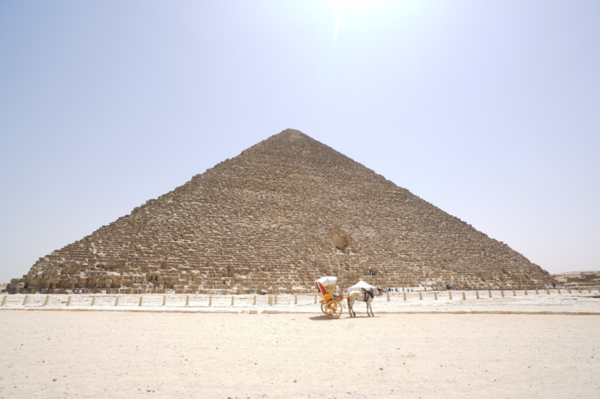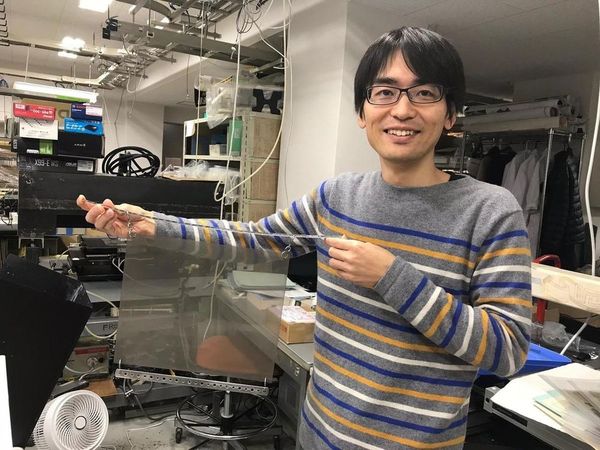The announcement of research at Nagoya University resulting in the discovery of a huge void inside a pyramid became big international news and garnered much attention recently. If you look behind this discovery you will find the story about nuclear emulsion plates that were used in the discovery -- a story that starts in the past and leads to the future, a story of persistence and a refusal to be beaten by the pyramid. These days a nuclear emulsion plate is a thin piece of plastic, or even just like a photographic film, and now called a nuclear emulsion film. In the world of research, digital systems that detect signals captured in real time and convert them to electrical signals have become mainstream technology, as in the case of Kamiokande (the Kamioka Nucleon Decay Experiment in Gifu Prefecture). As a result, the nuclear emulsion plates have generally fallen into disuse. It is like using an analog film camera in the heyday of the digital camera. But it is actually this "obsolete" technology that hit a homerun this time. In the pyramid research project, this older technology did have digital rivals, but it was so-called low-tech that prevailed, with its advantages of being able to fit into confined spaces and not needing electrical power.
Why the preference for the nuclear emulsion films? They produce high-resolution images. They have the advantage of an overwhelmingly better performance to show things in detail, and this is similar to the strong preference some people have for photographs taken with silver halide films. Meidai also has a tradition of elementary particle research that advanced together with the nuclear emulsion plate and led to the Kobayashi-Maskawa theory, which resulted in a Nobel Prize. Even though manufacturers had stopped production of film, researchers here created a cutting-edge system unrivaled in the world, including equipment to read the film, by learning those technologies through repeated improvements in the lab. These are the reasons Meidai researchers were given the otherwise elusive permission to do the research inside the pyramid.
And now film manufacturers are reportedly paying attention once again to nuclear emulsion films as a technique to peer inside structures. This technique has been used to see inside volcanos and a nuclear reactor at TEPCO's Fukushima Daiichi nuclear power station damaged by an accident. The technique holds great promise, including its use for non-invasive inspections of tunnels, bridges, and other civil engineering structures. It could result in significant business opportunities in the face of concerns about the aging and deterioration of structures like these.
 Pharoah Khufu's pyramid, where a void was newly discovered
Pharoah Khufu's pyramid, where a void was newly discovered
So, how does one actually "see" the inside of a pyramid?
"It's like an X-ray image made using cosmic rays," says the research leader, Designated Assistant Prof. Kunihiro Morishima of the Graduate School of Science of Nagoya University. Particles known as muons are among the cosmic rays that arrive here from space, and compared to X-rays used for X-ray imaging, they have a vastly greater ability to pass through objects. The higher their energy the more easily they can pass through dense matter. Similar to how photographic film works, a nuclear emulsion film is placed under the object you want to observe to "expose" it to the muons that pass through. Once the film is developed and the image is analyzed, you can see the distribution of muon-blocking material.
The nuclear emulsion films can produce images at the extremely high resolution of 0.2 microns (one micron is a thousandth of a millimeter). With a charge-coupled device (CCD) in a digital camera, light is received by sensors and converted into electrical signals. If the sensors are small, more can be packed in to increase the resolution of the image, but the smaller they are the less their sensitivity. As a result of that balancing act, a CCD will only have about one-tenth the resolution of a nuclear emulsion film.
As an additional feature, with a nuclear emulsion film it is possible to have a three-dimensional view of the trajectory of particles that have passed through, as the detection layer of film coated with a silver bromide emulsion has a thickness of a few dozen to a few hundred microns. This is another huge advantage over CCD technology and conventional photography, which only display a flat image. "Silver halide film is an old technology, but nothing can compete with it in what you can see," says Morishima explaining his obvious preference.

Designated Assistant Prof. Kunihiro Morishima showing a nuclear emulsion film
Nagoya University has a history of research with nuclear emulsion plates spanning more than half a century......>>read more on the Meidai Watch